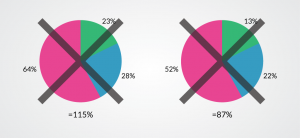When you put all of your blood, sweat, and tears into developing what you believe is the best email marketing campaign to date, you want to know that your emails are going to be delivered and engaged with.
But, did you know that 14.3% percent of emails never reach a recipient’s inbox, which means they are unlikely to be opened and interacted with?
There are numerous things that jeopardize the deliverability of your email, but there are also several different steps you can take to keep your email deliverability rate as high as possible.
You’ll learn all of this and more, including the difference between email delivery and email deliverability — two terms that are often used interchangeably and shouldn’t be.
- What is Email Deliverability?
- Email Delivery vs. Email Deliverability
- What is Considered Good Email Deliverability?
- What Affects Email Deliverability?
- How to Guarantee a Great Email Deliverability
- Wrap Up
What is Email Deliverability?
Email deliverability is defined as the ability to get your email and its content to the inbox of your recipient.
You’re probably thinking: “Oh, that’s easy!” However, the truth of the matter is it isn’t.
Emails go through a long, tedious process from the time you press send to the time it shows up in the recipient’s inbox — and this is if that’s where it ends up landing.
Sometimes, emails will end up in Spam, Promotions, etc., which is not what you want.
Email Delivery vs. Email Deliverability
Email delivery and email deliverability are two terms with different meanings, even though they are often used interchangeably.
Let’s look at each one on their own to make it easier to understand the difference between these two marketing terms.
Email Delivery: What It Means
Email delivery refers to whether or not the recipient accepts the email.
This process comes before the distinction of where the email will land and refers to whether your IP address was blocked or the email address was incorrect.
For example, if your email fails to make it into the inbox, then delivery was unsuccessful.
Email Deliverability: What It Means
Email deliverability refers to whether or not the email arrives in the inbox or whether it ends up being placed in the Spam folder, Promotions folder, or any other kind of folder present.
There are three factors that are taken into consideration when determining email deliverability.
Identification
This part of the process works to identify who you are, using a variety of protocols. Essentially, this step is like a background check.
Reputation
Everyone has a sender reputation. This score determines the trustworthiness of your emails. The most effective way to increase this number is for recipients to mark you as a trusted email sender.
Content
Your content plays a big role as well, especially in terms of formatting, relevance, and appropriateness. The key here is to ensure your subject line corresponds well with your email message.
Identification and reputation remain the majority of reasons why your email lands in the folder it does.
Basically, a delivery issue means that you are dealing with a defective email address or there has been a negative interaction that blocks it.
A deliverability issue means that your recipients aren’t interested in the content or you are not following current sending/permission tactics.
What is Considered Good Email Deliverability?
Obviously, the goal of every brand is to have 100% email deliverability. Unfortunately, the likelihood of this happening is slim.
Most senders in the United States have an inbox placement average of 77%. The remainder of the emails head to the Spam folder or “disappear”.
Your email deliverability rate will vary based on the sending platform you’re using.
However, a good email deliverability rate tends to be at least 95%, but you may find yourself more between 85 and 95%. Further, your bounce rate should never be higher than 3 or 4%.
What Affects Email Deliverability?
One of the biggest enemies you face when it comes to email deliverability is the Internet Services Providers (ISPs).
ISPs have an assortment of tools in their arsenal to keep spam from reaching the Inbox. Unfortunately, these tools can have a direct impact on your email deliverability, since the ISPs have such a plethora of emails to manage.
ISPs set a sending limit for all senders
When they believe you have reached this sending limit within a certain period of time, your email will sustain a soft bounce.
This number may be set daily or weekly, depending on the frequency at which you send emails. The newer a sender you are or the less popular sender reputation you have, the more likely the ISP will be stricter with its sending limits.
ISPs may block your emails
This usually results from recipients marking your mail as spam or having your email hard bounce repeatedly.
The good news is that blocks don’t normally last more than a couple of days to a week.
Engagement from your recipients is important
If your recipient is receiving your emails but failing to open them, then this alerts the ISP that you may not be following positive sending tactics.
This means your emails go to the Spam folder. This can have a direct negative impact on your sender reputation.
In many cases, it is better off on your end to get rid of inactive contacts instead of simply waiting for them to come around.
Trust us, it is better to have a smaller list of subscribers who are active than a larger list with the bulk of them being inactive.
How to Guarantee a Great Email Deliverability
Now that you are familiar with the difference between email delivery and email deliverability, you need to figure out how to improve your deliverability rate.
In doing so, you will automatically improve your overall email marketing strategy.
1. Obtain Email Authentication
You know how you don’t answer phone calls from random numbers that you don’t know? Well, ISPs won’t trust emails coming in from suspicious and unfamiliar senders.
This is why authenticating your email and yourself as legitimate is so important. Without authentication, your email deliverability rate would suffer considerably.
2. Create a Quality Email Subscriber List
Permission-based marketing is important, but as far as your emails go, it is possible for these permissions to expire.
As we’ve mentioned, inactive recipients can have a negative impact on your email deliverability rate, so you will want to take them out of your subscriber list.
If you notice you are having some issues with deliverability, your subscriber list is a good place to start.
There may be fake or invalid emails that need to be removed. After all, 30 percent of subscribers will change their email addresses annually.
Make sure to clean up your subscriber list on a regular basis to maintain fluency within your sends.
3. Make It Easy to Unsubscribe
One of the best ways to avoid winding up in the Spam folder is ensuring you have an easy, properly working unsubscribe mechanism within the content of your email.
This allows subscribers who no longer want to receive your emails to easily opt-out of them, which is only going to help your email deliverability rates in the long run.
By only sending emails to those who want to engage, you are:
- Increasing the chance of the email being opened.
- Improving the potential for clicks.
- Decreasing the bounce rate.
You should also send our sporadic emails throughout the year asking your subscribers if they’re still interested and want to remain on your email list or if they would like to unsubscribe due to disinterest.
Doing this will help ensure you maintain a list of subscribers who are interested and are more likely to actively engage with your emails as they are sent out.
4. Work Your Way Up
To ensure your emails don’t get blocked or bounced due to starting your email marketing campaign off too quickly, you will want to ramp things up gradually.
So, you will want to send small batches of emails, and it is best to send this to recipients that you know will engage with them.
As these emails of your campaign are delivered, received, and opened, you will start to gain trust from the ISP. Continue to ramp your way up to the peak email sending volume you would like to achieve.
Opting to simply send a large batch of emails from the get-go will result in the ISP labeling you as a threat, leading to your email being marked as spam.
5. Personalize Your Content
Ultimately, spam means something different for subscribers and marketers.
Subscribers want to receive emails that are relevant and interesting. When this is not what they get, they often view the content as spam.
So, before you press send on your emails, ask yourself again whether the content is relevant and check it for any errors.
Sending personalized and relevant emails can have a positive impact on your email deliverability rate while also improving engagement and fostering trustworthy relationships with your subscribers.
Wrap Up
By now being familiar with the difference between email delivery and email deliverability, you may be able to take your email marketing campaign to the next level.
This is especially true if you utilize the tactics outlined within this blog, ensuring your emails make it to subscribers’ inboxes instead of Spam folders.
To further improve your email marketing campaign, make sure you are familiar with how to create an email marketing funnel that stands the test of time, increasing the chance of conversion.







